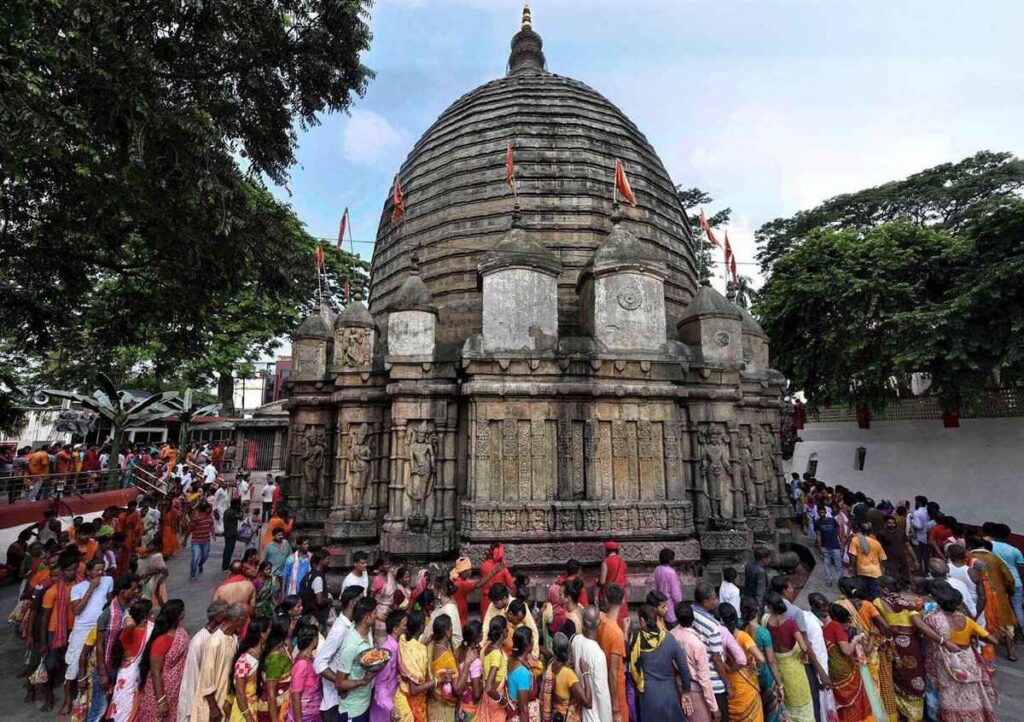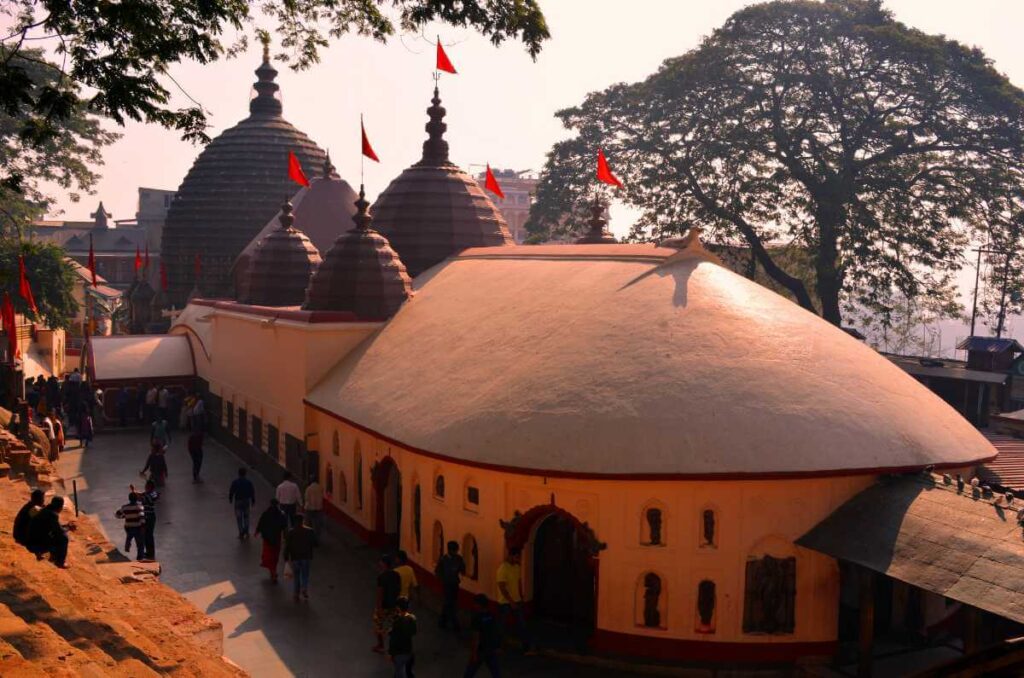A brief overview of Ambubashi Mela

Ambubashi Mela, often referred to as the ‘Mahakumbh of the East’, is a festival steeped in mystique and sanctity. Held annually at the Kamakhya Temple in Guwahati, Assam, it marks the period of the earth’s menstruation and fertility. During this time, the temple doors remain closed for three days, symbolizing the menstruation of Goddess Kamakhya. Pilgrims from across the nation flock to this sacred site, not just to seek blessings but to immerse themselves in a spiritual experience that transcends the ordinary.
The festival resumes with great fervor on the fourth day when the temple doors reopen, signifying the end of the Goddess’s period. The sanctified water, or ‘Amrit’, is distributed among the devotees, believed to possess healing properties. The Ambubashi Mela is not just a religious gathering; it’s a vibrant confluence of faith, culture, and tradition that showcases the rich tapestry of Assamese heritage.
Significance in Assamese culture
In the heart of Assam’s vibrant cultural landscape, the Ambubashi Mela holds a place of reverence and celebration. It is a time when the state’s spiritual ethos comes to the forefront, showcasing the deep-rooted belief in the divine feminine power. The festival symbolizes fertility and the nurturing aspect of Mother Earth, resonating with the agrarian communities that form the backbone of Assamese society.
The Mela serves as a reminder of the harmonious coexistence between nature and mankind, a core tenet of Assamese culture. It’s a period when people from diverse backgrounds unite in devotion, setting aside their daily lives to partake in a tradition that has been passed down through generations. The Ambubashi Mela is not just significant for its religious aspects but also as a time for reaffirming social bonds and cultural identity among the Assamese people.
The mythology associated with Ambubashi Mela
The Ambubashi Mela is shrouded in the ancient legend of Goddess Kamakhya, the presiding deity of the Kamakhya Temple. According to mythology, the Goddess goes through her annual cycle of menstruation during this period. It is believed that the Brahmaputra River turns red, symbolizing the Goddess’s fertility.
This legend is not merely a tale but a cornerstone of the festival’s rituals and practices. It emphasizes the power of Shakti, the divine feminine energy, and its role in creation and life. The mythology associated with Ambubashi Mela is a profound narrative that connects the cosmic cycles to human existence, celebrating the Goddess’s ability to give life and sustain it.
Kamakhya Temple – The Epicenter of Faith

Description of the Kamakhya Temple
Perched atop the Nilachal Hill in Guwahati, the Kamakhya Temple stands as a majestic testament to the spiritual devotion of Assam. This ancient temple, dedicated to Goddess Kamakhya, is an architectural marvel that blends the traditional Nilachal type with the Shikhara style. Its beehive-like shikhara and intricate carvings tell tales of a rich historical legacy.
Architectural and spiritual importance
Beyond its architectural grandeur, the temple is a nucleus of spiritual energy for devotees. It is one of the 51 Shakti Peethas, making it a pilgrimage of paramount importance in Hinduism. The Kamakhya Temple transcends mere physical beauty, embodying the essence of divine femininity and serving as a beacon of faith that draws millions into its sacred embrace.
Ambubashi Mela: A Segment of Rituals and Rites
The Ambubashi Mela is a significant festival that takes place in the Kamakhya Temple of Guwahati, Assam, India. It is a celebration that honors the menstruation course of the goddess Kamakhya.
- Historical Context: The festival has ancient origins and is deeply rooted in the Tantric traditions of Hinduism, symbolizing fertility and the sanctity of the menstrual cycle.
- Cultural Impact: It draws devotees from all over India, showcasing a blend of ritualistic practices unique to Assamese culture.
- Ritual Practices: During Ambubashi Mela, the temple remains closed for three days as it is believed that the Earth is menstruating and during this time, various rites and rituals are performed.
- Pilgrimage Significance: Pilgrims believe that visiting the temple during this festival will bestow blessings and fertility, making it a vital rite for many.
- Festivities and Fair: Post the three-day period, the temple doors reopen and a grand fair ensues, celebrating life and divine femininity.
- Modern Observances: Despite its ancient roots, Ambubashi Mela continues to thrive, adapting to contemporary times while preserving its traditional essence.
The Ambubashi Mela is a profound example of how rituals and rites serve as a bridge between the divine and the earthly, reflecting deep-seated beliefs in the cyclical nature of life.
The Festive Colors of Ambubashi
The Ambubashi Mela is a kaleidoscope of colors, a visual spectacle that paints the Kamakhya Temple in hues of devotion and celebration. As one of Assam’s most vibrant festivals, it is a sensory feast that unfolds amidst the verdant hills.
Visual Description of the Festival’s Atmosphere
Reds and oranges dominate the scene, reflecting the traditional attire of sadhus and sanyasis who gather in large numbers. The air buzzes with chants and hymns, while the scent of incense and floral offerings permeates the surroundings. Devotees move in waves, their faces lit with reverence and joy, adding to the dynamic canvas of this spiritual gathering. The festival is not just an event; it’s a living painting that captures the essence of life’s perpetual cycle.
The Cultural Tapestry of Ambubashi Attendees
Ambubashi Mela is not just a local festival; it’s a confluence of diverse cultures. The attendees of the Mela form a rich cultural tapestry that is as varied as it is vibrant.
- Diverse Pilgrims: From local Assamese devotees to international visitors, the festival attracts a wide array of pilgrims, each bringing their own customs and traditions.
- Spiritual Seekers: Ascetics, sadhus, and spiritual seekers from different sects and backgrounds converge, creating a melting pot of philosophies and practices.
- Artistic Expressions: Artists and performers showcase regional arts, crafts, and performances, adding layers of cultural richness to the event.
- Culinary Delights: The food stalls offer a taste of Assam’s gastronomic diversity, with traditional dishes and flavors for everyone to savor.
- Social Interactions: The Mela serves as a social venue where stories are shared, friendships are formed, and cultural exchanges take place.
- Traditional Attire: A visual treat of traditional garments and adornments provides a glimpse into the myriad cultures represented at the festival.
Exploration of Local Markets and Trade
During the Ambubachi Mela, the local markets around the temple come alive with vibrant colors, fragrances, and bustling activity. Here’s what you’ll find:
- Market Stalls:
- Traders set up stalls selling religious artifacts, handicrafts, clothing, and souvenirs.
- Devotees purchase items as offerings or keepsakes.
- Spiritual Commerce:
- The convergence of faith and commerce is evident as pilgrims buy items for rituals and prayers.
- The market becomes a hub for spiritual exchange.
Beyond the Mela – Exploring Assam
The Jonbeel Mela stands out as a distinctive marketplace in Assam, diverging from conventional trade practices. Here’s what you need to know:
- Barter Tradition:
- Instead of using currencies, this fair revolves around the ancient tradition of bartering.
- Goods don’t exchange hands through typical transactions; instead, creators and buyers engage directly, negotiating mutually satisfactory exchanges.
- For half a millennium, this traditional bazaar has been the stage for this unique practice.
- Enchanting Location:
- The Jonbeel Mela takes place in the picturesque village of Dayang Belguri, nestled in the Morigaon District of Assam.
- The fair aligns its schedule with the vibrant celebration of Magh Bihu (Bhogali Bihu), marking the grand harvest festival in the region.
- The name “Jonbeel” translates to “moon” and “wetland” in the local vernacular, reflecting its enchanting location along the banks of a crescent-shaped water body.
- Regional Abundance:
- Under vibrant canopies, a diverse array of goods and delectable edibles await visitors.
- Traditional apparel, spices, herbs, Indigenous garments, rice, sweet rice cakes (‘pithas’), and fresh fish are meticulously displayed.
- The fair also features betel leaves, areca nuts, zesty lime, black pepper, mustard seeds, and rustic earthenware.
- Legacy of the Ahom Kings:
- In an era where several fairs dotted the landscape, Jonbeel Mela emerges as the sole surviving representative of its genre.
- Beyond barter, these traditional fairs served broader purposes centuries ago, reflecting socio-political significance within the Ahom Kingdom.
Reflections on the Ambubashi Mela’s impact on spirituality and community
- Spiritual Renewal:
- The Mela serves as a powerful catalyst for spiritual introspection.
- Devotees gather to connect with the divine, seeking blessings and renewal.
- The belief in Goddess Kamakhya’s sacred menstruation cycle transcends the physical, symbolizing cosmic rhythms and creation.
- Unity Amid Diversity:
- The Mela transcends caste, creed, and social status.
- Pilgrims from diverse backgrounds come together, fostering a sense of unity.
- The shared devotion erases boundaries, emphasizing our common humanity.
- Community Bonding:
- Families, friends, and strangers share meals, stories, and prayers.
- The Mela becomes a vibrant tapestry of human connections.
- Amid the bustling crowds, hearts find solace in collective worship.
- Economic Impact:
- Beyond spirituality, the Mela fuels local economies.
- Traders, artisans, and vendors thrive during these days.
- Commerce merges seamlessly with devotion, sustaining livelihoods.
FAQ’s
-
Q. What is Ambubachi Mela?
A: Ambubachi Mela is an annual Hindu festival celebrated in the Kamakhya Temple, situated in Guwahati, Assam, India. The festival marks the annual menstruation of the goddess Kamakhya, symbolizing fertility and the nurturing power of the Mother Earth.
-
Q. When is Ambubachi Mela celebrated?
A: The festival is observed during the monsoon season, typically in the month of June. It lasts for four days, beginning on the seventh day of the Assamese month Ahaar and concluding on the tenth day.
-
Q. Why is Ambubachi Mela significant?
A: Ambubachi Mela holds great religious and cultural significance as it celebrates the creative and nurturing powers of the goddess Kamakhya. It is a time for devotees to seek blessings for fertility, prosperity, and overall well-being.
-
Q. Is there any special dress code for attending the Mela?
A: While there is no strict dress code, it is advisable to wear modest and respectful attire while visiting the temple and participating in the rituals. White or red traditional clothes are commonly worn by many devotees.



![kihikila.in[ambubachi]_11zon](https://www.kihikila.in/wp-content/uploads/2024/06/kihikila.inambubachi_11zon.jpg)
